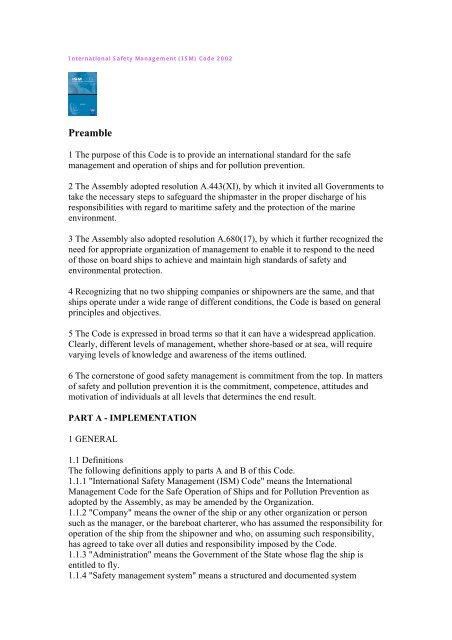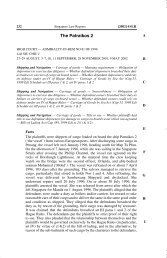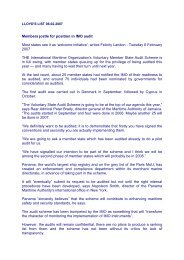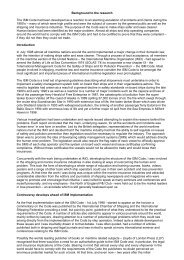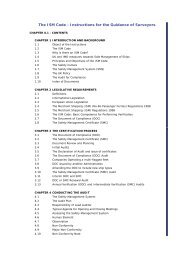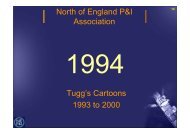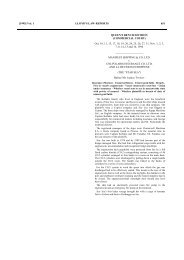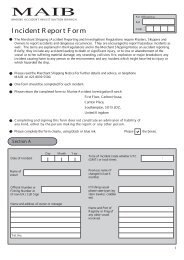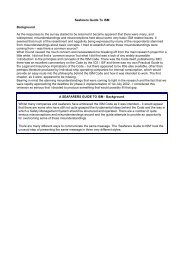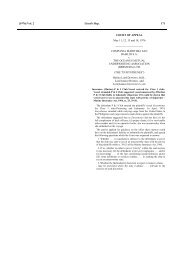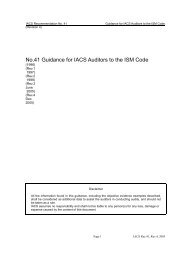International Safety Management (ISM) Code 2002
International Safety Management (ISM) Code 2002
International Safety Management (ISM) Code 2002
You also want an ePaper? Increase the reach of your titles
YUMPU automatically turns print PDFs into web optimized ePapers that Google loves.
<strong>International</strong> <strong>Safety</strong> <strong>Management</strong> (<strong>ISM</strong>) <strong>Code</strong> <strong>2002</strong>Preamble1 The purpose of this <strong>Code</strong> is to provide an international standard for the safemanagement and operation of ships and for pollution prevention.2 The Assembly adopted resolution A.443(XI), by which it invited all Governments totake the necessary steps to safeguard the shipmaster in the proper discharge of hisresponsibilities with regard to maritime safety and the protection of the marineenvironment.3 The Assembly also adopted resolution A.680(17), by which it further recognized theneed for appropriate organization of management to enable it to respond to the needof those on board ships to achieve and maintain high standards of safety andenvironmental protection.4 Recognizing that no two shipping companies or shipowners are the same, and thatships operate under a wide range of different conditions, the <strong>Code</strong> is based on generalprinciples and objectives.5 The <strong>Code</strong> is expressed in broad terms so that it can have a widespread application.Clearly, different levels of management, whether shore-based or at sea, will requirevarying levels of knowledge and awareness of the items outlined.6 The cornerstone of good safety management is commitment from the top. In mattersof safety and pollution prevention it is the commitment, competence, attitudes andmotivation of individuals at all levels that determines the end result.PART A - IMPLEMENTATION1 GENERAL1.1 DefinitionsThe following definitions apply to parts A and B of this <strong>Code</strong>.1.1.1 "<strong>International</strong> <strong>Safety</strong> <strong>Management</strong> (<strong>ISM</strong>) <strong>Code</strong>" means the <strong>International</strong><strong>Management</strong> <strong>Code</strong> for the Safe Operation of Ships and for Pollution Prevention asadopted by the Assembly, as may be amended by the Organization.1.1.2 "Company" means the owner of the ship or any other organization or personsuch as the manager, or the bareboat charterer, who has assumed the responsibility foroperation of the ship from the shipowner and who, on assuming such responsibility,has agreed to take over all duties and responsibility imposed by the <strong>Code</strong>.1.1.3 "Administration" means the Government of the State whose flag the ship isentitled to fly.1.1.4 "<strong>Safety</strong> management system" means a structured and documented system
enabling Company personnel to implement effectively the Company safety andenvironmental protection policy.1.1.5 "Document of Compliance" means a document issued to a Company whichcomplies with the requirements of this <strong>Code</strong>.1.1.6 "<strong>Safety</strong> <strong>Management</strong> Certificate" means a document issued to a ship whichsignifies that the Company and its shipboard management operate in accordance withthe approved safety management system.1.1.7 "Objective evidence" means quantitative or qualitative information, records orstatements of fact pertaining to safety or to the existence and implementation of asafety management system element, which is based on observation, measurement ortest and which can be verified.1.1.8 "Observation" means a statement of fact made during a safety management auditand substantiated by objective evidence.1.1.9 "Non-conformity" means an observed situation where objective evidenceindicates the non-fulfilment of a specified requirement.1.1.10 "Major non-conformity" means an identifiable deviation that poses a seriousthreat to the safety of personnel or the ship or a serious risk to the environment thatrequires immediate corrective action and includes the lack of effective and systematicimplementation of a requirement of this <strong>Code</strong>.1.1.11 "Anniversary date" means the day and month of each year that corresponds tothe date of expiry of the relevant document or certificate.1.1.12 "Convention" means the <strong>International</strong> Convention for the <strong>Safety</strong> of Life at Sea,1974, as amended.1.2 Objectives1.2.1 The objectives of the <strong>Code</strong> are to ensure safety at sea, prevention of humaninjury or loss of life, and avoidance of damage to the environment, in particular to themarine environment and to property.1.2.2 <strong>Safety</strong> management objectives of the Company should, inter alia:.1 provide for safe practices in ship operation and a safe working environment;.2 establish safeguards against all identified risks; and.3 continuously improve safety management skills of personnel ashore and aboardships, including preparing for emergencies related both to safety and environmentalprotection.1.2.3 The safety management system should ensure:.1 compliance with mandatory rules and regulations; and.2 that applicable codes, guidelines and standards recommended by the Organization,Administrations, classification societies and maritime industry organizations are takeninto account.1.3 ApplicationThe requirements of this <strong>Code</strong> may be applied to all ships.
1.4 Functional requirements for a safety management systemEvery Company should develop, implement and maintain a safety managementsystem which includes the following functional requirements:.1 a safety and environmental-protection policy;.2 instructions and procedures to ensure safe operation of ships and protection of theenvironment in compliance with relevant international and flag State legislation;.3 defined levels of authority and lines of communication between, and amongst,shore and shipboard personnel;.4 procedures for reporting accidents and non-conformities with the provisions of this<strong>Code</strong>;.5 procedures to prepare for and respond to emergency situations; and.6 procedures for internal audits and management reviews.2 SAFETY AND ENVIRONMENTAL-PROTECTION POLICY2.1 The Company should establish a safety and environmental-protection policywhich describes how the objectives given in paragraph 1.2 will be achieved.2.2 The Company should ensure that the policy is implemented and maintained at alllevels of the organization, both ship-based and shore-based.3 COMPANY RESPONSIBILITIES AND AUTHORITY3.1 If the entity who is responsible for the operation of the ship is other than theowner, the owner must report the full name and details of such entity to theAdministration.3.2 The Company should define and document the responsibility, authority andinterrelation of all personnel who manage, perform and verify work relating to andaffecting safety and pollution prevention.3.3 The Company is responsible for ensuring that adequate resources and shore-basedsupport are provided to enable the designated person or persons to carry out theirfunctions.4 DESIGNATED PERSON(S)To ensure the safe operation of each ship and to provide a link between the Companyand those on board, every Company, as appropriate, should designate a person orpersons ashore having direct access to the highest level of management. Theresponsibility and authority of the designated person or persons should includemonitoring the safety and pollution-prevention aspects of the operation of each shipand ensuring that adequate resources and shore-based support are applied, as required.5 MASTER'S RESPONSIBILITY AND AUTHORITY5.1 The Company should clearly define and document the master's responsibility withregard to:.1 implementing the safety and environmental-protection policy of the Company;.2 motivating the crew in the observation of that policy;.3 issuing appropriate orders and instructions in a clear and simple manner;
.4 verifying that specified requirements are observed; and.5 reviewing the safety management system and reporting its deficiencies to the shorebasedmanagement.5.2 The Company should ensure that the safety management system operating onboard the ship contains a clear statement emphasizing the master's authority. TheCompany should establish in the safety management system that the master has theoverriding authority and the responsibility to make decisions with respect to safetyand pollution prevention and to request the Company's assistance as may benecessary.6 RESOURCES AND PERSONNEL6.1 The Company should ensure that the master is:.1 properly qualified for command;.2 fully conversant with the Company's safety management system; and.3 given the necessary support so that the master's duties can be safely performed.6.2 The Company should ensure that each ship is manned with qualified, certificatedand medically fit seafarers in accordance with national and international requirements.6.3 The Company should establish procedures to ensure that new personnel andpersonnel transferred to new assignments related to safety and protection of theenvironment are given proper familiarization with their duties. Instructions which areessential to be provided prior to sailing should be identified, documented and given.6.4 The Company should ensure that all personnel involved in the Company's safetymanagement system have an adequate understanding of relevant rules, regulations,codes and guidelines.6.5 The Company should establish and maintain procedures for identifying anytraining which may be required in support of the safety management system andensure that such training is provided for all personnel concerned.6.6 The Company should establish procedures by which the ship's personnel receiverelevant information on the safety management system in a working language orlanguages understood by them.6.7 The Company should ensure that the ship's personnel are able to communicateeffectively in the execution of their duties related to the safety management system.7 DEVELOPMENT OF PLANS FOR SHIPBOARD OPERATIONSThe Company should establish procedures for the preparation of plans andinstructions, including checklists as appropriate, for key shipboard operationsconcerning the safety of the ship and the prevention of pollution. The various tasksinvolved should be defined and assigned to qualified personnel.8 EMERGENCY PREPAREDNESS8.1 The Company should establish procedures to identify, describe and respond topotential emergency shipboard situations.8.2 The Company should establish programmes for drills and exercises to prepare foremergency actions.
8.3 The safety management system should provide for measures ensuring that theCompany's organization can respond at any time to hazards, accidents and emergencysituations involving its ships.9 REPORTS AND ANALYSIS OF NON-CONFORMITIES, ACCIDENTS ANDHAZARDOUS OCCURRENCES9.1 The safety management system should include procedures ensuring that nonconformities,accidents and hazardous situations are reported to the Company,investigated and analysed with the objective of improving safety and pollutionprevention.9.2 The Company should establish procedures for the implementation of correctiveaction.10 MAINTENANCE OF THE SHIP AND EQUIPMENT10.1 The Company should establish procedures to ensure that the ship is maintainedin conformity with the provisions of the relevant rules and regulations and with anyadditional requirements which may be established by the Company.10.2 In meeting these requirements the Company should ensure that:.1 inspections are held at appropriate intervals;.2 any non-conformity is reported, with its possible cause, if known;.3 appropriate corrective action is taken; and.4 records of these activities are maintained.10.3 The Company should establish procedures in its safety management system toidentify equipment and technical systems the sudden operational failure of which mayresult in hazardous situations. The safety management system should provide forspecific measures aimed at promoting the reliability of such equipment or systems.These measures should include the regular testing of stand-by arrangements andequipment or technical systems that are not in continuous use.10.4 The inspections mentioned in 10.2 as well as the measures referred to in 10.3should be integrated into the ship's operational maintenance routine.11 DOCUMENTATION11.1 The Company should establish and maintain procedures to control all documentsand data which are relevant to the safety management system.11.2 The Company should ensure that:.1 valid documents are available at all relevant locations;.2 changes to documents are reviewed and approved by authorized personnel; and.3 obsolete documents are promptly removed.11.3 The documents used to describe and implement the safety management systemmay be referred to as the <strong>Safety</strong> <strong>Management</strong> Manual. Documentation should be keptin a form that the Company considers most effective. Each ship should carry on boardall documentation relevant to that ship.
12 COMPANY VERIFICATION, REVIEW AND EVALUATION12.1 The Company should carry out internal safety audits to verify whether safety andpollution-prevention activities comply with the safety management system.12.2 The Company should periodically evaluate the efficiency of and, when needed,review the safety management system in accordance with procedures established bythe Company.12.3 The audits and possible corrective actions should be carried out in accordancewith documented procedures.12.4 Personnel carrying out audits should be independent of the areas being auditedunless this is impracticable due to the size and the nature of the Company.12.5 The results of the audits and reviews should be brought to the attention of allpersonnel having responsibility in the area involved.12.6 The management personnel responsible for the area involved should take timelycorrective action on deficiencies found.PART B - CERTIFICATION AND VERIFICATION13 CERTIFICATION AND PERIODICAL VERIFICATION13.1 The ship should be operated by a Company which has been issued with aDocument of Compliance or with an Interim Document of Compliance in accordancewith paragraph 14.1, relevant to that ship.13.2 The Document of Compliance should be issued by the Administration, by anorganization recognized by the Administration or, at the request of theAdministration, by another Contracting Government to the Convention to anyCompany complying with the requirements of this <strong>Code</strong> for a period specified by theAdministration which should not exceed five years. Such a document should beaccepted as evidence that the Company is capable of complying with the requirementsof this <strong>Code</strong>.13.3 The Document of Compliance is only valid for the ship types explicitly indicatedin the document. Such indication should be based on the types of ships on which theinitial verification was based. Other ship types should only be added after verificationof the Company's capability to comply with the requirements of this <strong>Code</strong> applicableto such ship types. In this context, ship types are those referred to in regulation IX/1of the Convention.13.4 The validity of a Document of Compliance should be subject to annualverification by the Administration or by an organization recognized by theAdministration or, at the request of the Administration, by another ContractingGovernment within three months before or after the anniversary date.13.5 The Document of Compliance should be withdrawn by the Administration or, atits request, by the Contracting Government which issued the Document when theannual verification required in paragraph 13.4 is not requested or if there is evidenceof major non-conformities with this <strong>Code</strong>.13.5.1 All associated <strong>Safety</strong> <strong>Management</strong> Certificates and/or Interim <strong>Safety</strong><strong>Management</strong> Certificates should also be withdrawn if the Document of Compliance iswithdrawn.13.6 A copy of the Document of Compliance should be placed on board in order thatthe master of the ship, if so requested, may produce it for verification by theAdministration or by an organization recognized by the Administration or for the
purposes of the control referred to in regulation IX/6.2 of the Convention. The copy ofthe Document is not required to be authenticated or certified.13.7 The <strong>Safety</strong> <strong>Management</strong> Certificate should be issued to a ship for a period whichshould not exceed five years by the Administration or an organization recognized bythe Administration or, at the request of the Administration, by another ContractingGovernment. The <strong>Safety</strong> <strong>Management</strong> Certificate should be issued after verifying thatthe Company and its shipboard management operate in accordance with the approvedsafety management system. Such a Certificate should be accepted as evidence that theship is complying with the requirements of this <strong>Code</strong>.13.8 The validity of the <strong>Safety</strong> <strong>Management</strong> Certificate should be subject to at leastone intermediate verification by the Administration or an organization recognized bythe Administration or, at the request of the Administration, by another ContractingGovernment. If only one intermediate verification is to be carried out and the periodof validity of the <strong>Safety</strong> <strong>Management</strong> Certificate is five years, it should take placebetween the second and third anniversary dates of the <strong>Safety</strong> <strong>Management</strong> Certificate.13.9 In addition to the requirements of paragraph 13.5.1, the <strong>Safety</strong> <strong>Management</strong>Certificate should be withdrawn by the Administration or, at the request of theAdministration, by the Contracting Government which has issued it when theintermediate verification required in paragraph 13.8 is not requested or if there isevidence of major non-conformity with this <strong>Code</strong>.13.10 ‚Notwithstanding the requirements of paragraphs 13.2 and 13.7, when therenewal verification is completed within three months before the expiry date of theexisting Document of Compliance or <strong>Safety</strong> <strong>Management</strong> Certificate, the newDocument of Compliance or the new <strong>Safety</strong> <strong>Management</strong> Certificate should be validfrom the date of completion of the renewal verification for a period not exceeding fiveyears from the date of expiry of the existing Document of Compliance or <strong>Safety</strong><strong>Management</strong> Certificate.13.11 ‚When the renewal verification is completed more than three months before theexpiry date of the existing Document of Compliance or <strong>Safety</strong> <strong>Management</strong>Certificate, the new Document of Compliance or the new <strong>Safety</strong> <strong>Management</strong>Certificate should be valid from the date of completion of the renewal verification fora period not exceeding five years from the date of completion of the renewalverification."14 INTERIM CERTIFICATION14.1 An Interim Document of Compliance may be issued to facilitate initialimplementation of this <strong>Code</strong> when:.1 a Company is newly established; or.2 new ship types are to be added to an existing Document of Compliance, followingverification that the Company has a safety management system that meets theobjectives of paragraph 1.2.3 of this <strong>Code</strong>, provided the Company demonstrates plansto implement a safety management system meeting the full requirements of this <strong>Code</strong>within the period of validity of the Interim Document of Compliance. Such an InterimDocument of Compliance should be issued for a period not exceeding 12 months bythe Administration or by an organization recognized by the Administration or, at therequest of the Administration, by another Contracting Government. A copy of theInterim Document of Compliance should be placed on board in order that the masterof the ship, if so requested, may produce it for verification by the Administration or
y an organization recognized by the Administration or for the purposes of the controlreferred to in regulation IX/6.2 of the Convention. The copy of the Document is notrequired to be authenticated or certified.14.2 An Interim <strong>Safety</strong> <strong>Management</strong> Certificate may be issued:.1 to new ships on delivery;.2 when a Company takes on responsibility for the operation of a ship which is new tothe Company; or.3 when a ship changes flag.Such an Interim <strong>Safety</strong> <strong>Management</strong> Certificate should be issued for a period notexceeding 6 months by the Administration or an organization recognized by theAdministration or, at the request of the Administration, by another ContractingGovernment.14.3 An Administration or, at the request of the Administration, another ContractingGovernment may, in special cases, extend the validity of an Interim <strong>Safety</strong><strong>Management</strong> Certificate for a further period which should not exceed 6 months fromthe date of expiry.14.4 An Interim <strong>Safety</strong> <strong>Management</strong> Certificate may be issued following verificationthat:.1 the Document of Compliance, or the Interim Document of Compliance, is relevantto the ship concerned;.2 the safety management system provided by the Company for the ship concernedincludes key elements of this <strong>Code</strong> and has been assessed during the audit forissuance of the Document of Compliance or demonstrated for issuance of the InterimDocument of Compliance;.3 the Company has planned the audit of the ship within three months;.4 the master and officers are familiar with the safety management system and theplanned arrangements for its implementation;.5 instructions, which have been identified as being essential, are provided prior tosailing; and.6 relevant information on the safety management system has been given in a workinglanguage or languages understood by the ship's personnel.15 VERIFICATION15.1 All verifications required by the provisions of this <strong>Code</strong> should be carried out inaccordance with procedures acceptable to the Administration, taking into account theguidelines developed by the Organization.16 FORMS OF CERTIFICATES16.1 The Document of Compliance, the <strong>Safety</strong> <strong>Management</strong> Certificate, the InterimDocument of Compliance and the Interim <strong>Safety</strong> <strong>Management</strong> Certificate should bedrawn up in a form corresponding to the models given in the appendix to this <strong>Code</strong>. Ifthe language used is neither English nor French, the text should include a translationinto one of these languages.
16.2 In addition to the requirements of paragraph 13.3, the ship types indicated on theDocument of Compliance and the Interim Document of Compliance may be endorsedto reflect any limitations in the operations of the ships described in the safetymanagement system. ____________


